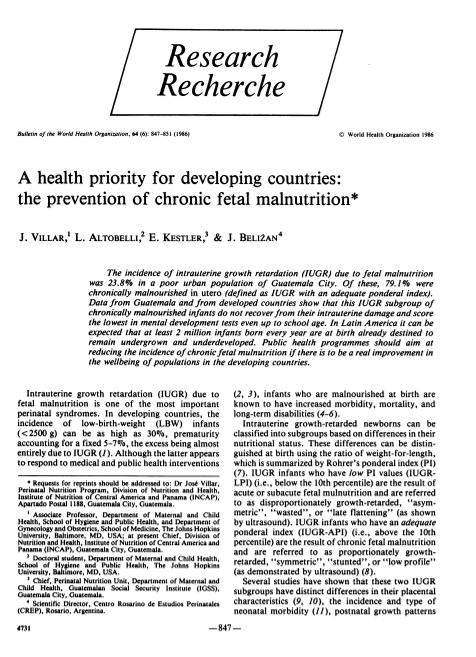Artículo
A health priority for developing countries: the prevention of chronic fetal malnutrition
Fecha de publicación:
02/2021
Editorial:
World Health Organization
Revista:
Bulletin of the World Health Organization
ISSN:
0042-9686
Idioma:
Inglés
Tipo de recurso:
Artículo publicado
Clasificación temática:
Resumen
A prospective study of 3557 consecutively born neonates from a lower middle class district in Guatemala City documented a 23.8% incidence of intrauterine growth retardation due to fetal malnutrition. Those infants whose weights are below the 10th percentile of a sex- and race-specific birthweight and gestational age distribution, based on a developed country population, were considered to manifest intrauterine growth retardation. Ponderal index values were then used to further classify this population as having chronic fetal malnutrition (above the 10th percentile of the standard distribution) or subacute fetal malnutrition (below the 10th percentile); the incidences of these conditions were 79.1% and 20.8%, respectively. The results of numerous studies carried out in various populations suggest that developing countries have a higher incidence of chronically malnourished infants within the intrauterine growth retardation population, while subacute fetal malnutrition is more prevalent in developed countries. Moreover, it has been shown that chronically malnourished infants do not recover from their intrauterine damage and score the lowest in mental development tests even up to school age. They remain lighter, shorter, and with a smaller head circumference until at least 3 years of age. Based on the incidence rates ascertained in this study, it can be estimated that at least 2 million infants born each year in Latin America are at risk of chronic intrauterine growth retardation. Screening programs are needed to identify at-risk mothers early in pregnancy so that medical and nutritional interventions can be implemented.
Palabras clave:
PREVENTION
,
CHRONIC FETAL MALNUTRITION
,
NUTRITION
Archivos asociados
Licencia
Identificadores
Colecciones
Articulos(CIESP)
Articulos de CENTRO DE INVESTIGACIONES EN EPIDEMIOLOGIA Y SALUD PUBLICA
Articulos de CENTRO DE INVESTIGACIONES EN EPIDEMIOLOGIA Y SALUD PUBLICA
Citación
Villar, J.; Altobelli, L.; Kestler, Edgar; Belizan, Jose; A health priority for developing countries: the prevention of chronic fetal malnutrition; World Health Organization; Bulletin of the World Health Organization; 64; 6; 2-2021; 847-851
Compartir




